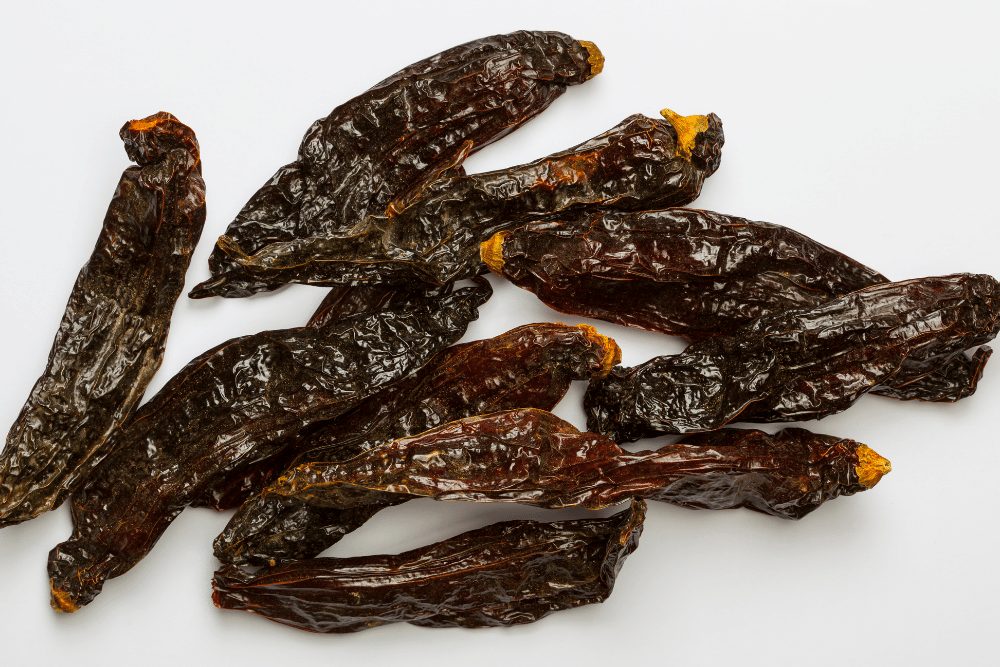As one of the many Peruvian aji chilis, aji panca peppers are commonly grown near the warm coastal areas of Peru and are used frequently in Peruvian recipes for their sweet, smoky flavor.
What Are Aji Panca Peppers?
Aji panca peppers are deep red to deep reddish-brown (burgundy) chilis averaging 3-5 inches long and 0.5 to 1.5 inches wide when fully mature.
Aji brown and panca chili are the other two names for the pepper around the world, while the aji panca is the South American name for the pepper. It’s also called the Peruvian red pepper.

Scientists botanically place aji panca chilis in the Capsicum baccatum species but are also closely associated with the Capsicum chinense species.
Aji panca chile peppers are indigenous to the Caribbean and are believed to have been brought by Spanish explorers to Peru, Ecuador, and Chile.
Since they entered Peru, aji panca peppers have been grown over the centuries, become closely identified with the country, and haven’t traveled outside the region much.
The popularity of aji panca has grown to the second most common aji pepper in Peruvian cuisine and a frequent pepper in South America, Central America, and US cuisines where it’s available.
Loved for their rich coloring, aji panca peppers turn from green and yellowish green during growth to deep red or deep reddish-brown when fully ripened. When fully mature, they get the name aji brown because of the earthy tone.
Panca chili peppers have medium-thick flesh. Their glossy skin is semi-smooth and looks slightly wrinkled.
You’ll be happy to know that besides being rich in vitamins A and C, aji panca chilis are also rich in minerals like potassium, iron, and calcium. Like all chili peppers, they’re a healthy addition to your daily diet!
How Spicy Are Aji Panca Chili Peppers?
Aji panca peppers are mildly spicy chilis. They score 1,000-1,500 Scoville Heat Units on the Scoville pepper heat scale.
The mild lingering heat of aji panca peppers endears them to most people, not to mention their complex flavor profile that combines sweetness and smokiness.
Aji panca peppers have a sweet, fruity taste that resembles that of berries like blackberries and blueberries. They also have a slightly smoky flavor.
The mild heat of the peppers gets even milder if you remove the seeds and veins, a common practice for people who want more of a sweet, fruity taste with less heat.
Dried aji panca peppers have a rich smoky flavor with undertones of mild, prolonged heat and a touch of berry-like flavor.
How Are Aji Panca Peppers Used?
Like most other mild peppers, aji panca peppers are highly versatile. You can use them in various forms or presentations such as fresh, raw, grilled and smoked, ground or powdered, blended into sauces, whole dried, or infused with vegetable or olive oil.
Have you come across and even eaten anticuchos? Anticuchos are a popular Peruvian dish of grilled chicken or beef skewers rubbed in aji panca chili powder or paste.
Fresh aji panca peppers are extremely hard to find, even in Peru, where the peppers are grown. The farmers usually leave the peppers to ripen and sun-dry on the plant before harvesting.
The dried chiles are then ground into chili powder. Aji panca pepper paste and sauce are made from fresh chopped or dried ground peppers.
Below are other common uses of aji panca chili peppers that you can try:
- Drying and blending with oil and vinegar to make panca chili paste for use as a condiment for vegetables, cooked meats, and fish
- Adding to barbecue sauces for South American-style ribs
- If raw, stuff them with your favorite stuffed pepper ingredients and roast them whole
- Whisking with lime juice or blending into marinades
- Crumbling and pressing into meats as a dry rub
- Making aji panca chili powder
- As a side dish for various meat dishes
- Enhancing stews, soups, salsas, casseroles, and fish
- Complementing other sauces and seasonings, such as Mexican mole sauces and adobo seasoning
- If raw or fresh, chop and add them to salads
- Complementing other peppers, such as aji amarillo pepper to blend sweetness, spiciness, smokiness, and fruitiness
- As a dipping sauce
Is Aji Panca Paste Spicy?
Aji panca paste can have the same mild spiciness as the aji panca chili it is derived from.
The critical thing you’ll want to note here is that, just like the peppers, the spiciness of the paste can be made milder if the seeds and veins are removed when making the paste. The oil and any other ingredients, such as spices and herbs, further dilutes the heat, making aji panca paste one of the milder chili pastes.

Where To Buy Aji Panca Sauce
Since fresh aji panca peppers are rare in the US and other parts of the world, you may opt for aji panca sauce, available online from different manufacturers in outlets like Amazon and Instacart.
If you want to make your own aji panca sauce instead, you’ll have to buy pepper seeds online to grow your own pods.
Alternatively, when you visit the country, you can buy dried aji panca chilis from international markets or from local Peruvian markets. Most Latin and Asian food stores carry aji panca chili jarred paste and dry peppers.
What Can You Use Instead Of Aji Panca?
You can replace aji panca with arroz con pollo peppers for similar mildness, pasilla peppers for a chocolatey flavor, and ancho chiles for sweetness and earthiness. You can sub the peppers with red jalapenos, inca red drop, rocoto, and serranos to kick up the heat.
Chipotle powder (dried and smoked jalapeno) is also an ideal sub for aji panca chiles. It is hotter but has the same smoky flavor as aji panca.
Ancho powder or ancho paste from dried poblano peppers has a sweet and smoky flavor similar to aji panca.
Aji amarillo peppers make an excellent hotter substitute for aji panca when you want to stay within the aji peppers realm.
You could also use other aji peppers, albeit with varying heat levels, than aji panca. Think of aji limo, aji caballero, aji charapita, aji habanero, aji rojo, and others.
What’s The Difference Between Aji Panca And Aji Amarillo?
Aji panca and aji amarillo are often confused because of their similar shape. Their difference lies in their spiciness—aji panca peppers are fresher and milder than spicier aji amarillo peppers.

